For renters on a budget, finding affordable apartment rentals in a big city is not an easy feat. In this study, we analyze how distances from various boundaries separating contiguous neighborhoods in Chicago could influence the median rents of apartments.
Key Findings from the Study:
- A consistent trend of declining median rents per month as the distance from the city center increases
- Among the neighborhoods nearest to the city center, renters can expect a major price drop of $440 in median rent per month just 200 m north of Chicago Avenue in Near North Side
- Among the neighborhoods furthest from the city center, renters can expect a significant drop of $287.50 in median rent per month 400 m away from W Devon Avenue in Rogers Park
- A decrease in median rent averaging of about $151.67 can be observed across boundaries separating neighborhoods Andersonville-Edgewater, Lincoln Park-Lake View, and Wrightwood Neighbors-Sheffield Neighbors and Lincoln Park
Overall Trend of Chicago Neighborhoods (North to South)
You can use the interactive column chart to observe the median rent behavior across the city from North (Rogers Park) to South (Near North Side). You can also scroll or adjust the scrollbar at the bottom of the chart to zoom into a specific region.
An overview of the general trend of the median rents of apartments across distances of 200 m interval follows a gentle increasing slope towards the city center. Of course, it doesn’t come as a surprise to us that rent prices around the city center are higher than in neighborhoods at further distances due to greater accessibility, convenience, proximity to entertainment, and other various reasons.
We’ve heard about the oversupply of apartments in Chicago’s downtown rental market, and the proposed Tribune Tower project which will soon add even more units to the already overcrowded space in the downtown area. While Downtown Chicago is not the main focus of this study, we seek to investigate if there are any trends in median rents across various distances from the neighborhood boundaries along North Side towards Downtown Chicago.
Navigation: Chicago Ave | W Devon Ave | W Bryn Mawr Ave | W Diversey Pkwy | W Fullerton Ave
Chicago Ave
Our findings showed that apartment median rents decrease from south of Chicago Ave to north of the avenue, with median rents dropping the most 200 m north of Chicago Ave, by about $440 per month.
Located north and east of the Chicago River and bounded by Lake Michigan to its east, Near North Side is an affluent downtown community area. River North is a neighborhood within Near North Side and it is also known to be a happening, urban neighborhood – the city center’s art and nightlife scene, with many new workspaces for designers and programmers and new high-end condos. It’s home to many art galleries along the River North Art District, such as the famous Addington Gallery and Driehaus Museum.
Here, we learn from the plot below that the trend of 1-bedroom median rents follows a gentle decline from south to north of Chicago Avenue.
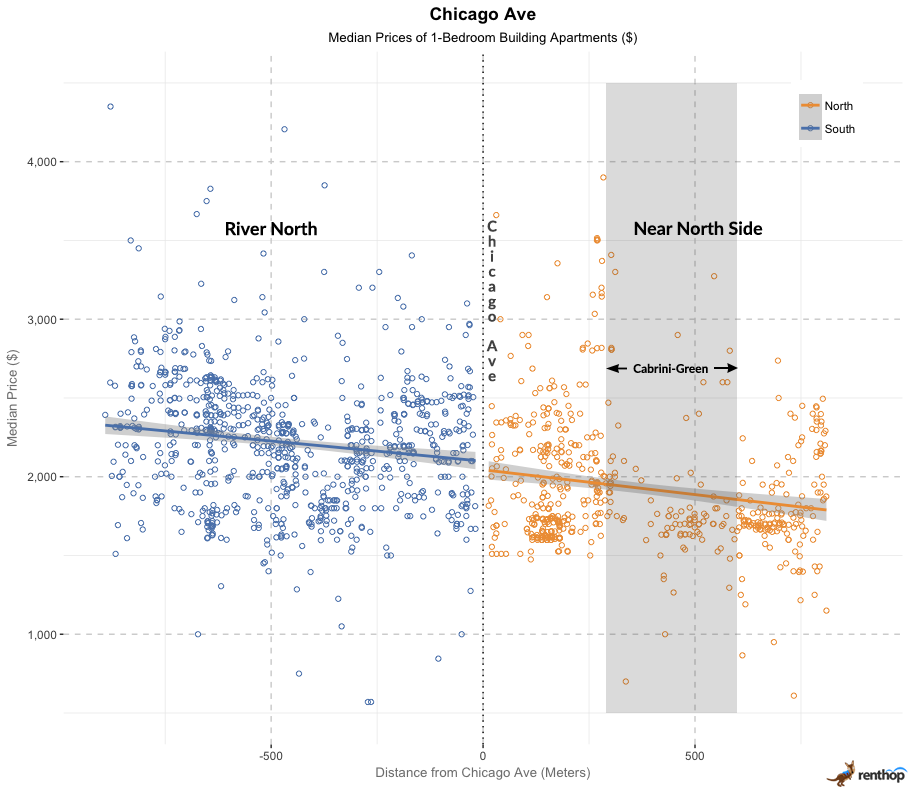
The region between 290 m to 600 m (highlighted in the grey) above Chicago Ave indicates a fewer number of apartments, which coincides with the Cabrini-Green neighborhood.
The Cabrini-Green Homes used to house about 15,000 residents at its peak. However, over the years, the rise of crime and gang violence activities created unfavorable living conditions for its residents. This eventually led to the demolition of high-rise buildings, with the last demolition carried out in 2011. In our study on the effect of crime on rent prices, we have discovered that crime is negatively correlated with rent prices. It might be possible that the activities in the Cabrini-Green neighborhood might have caused the change in the median rents across the neighborhoods.
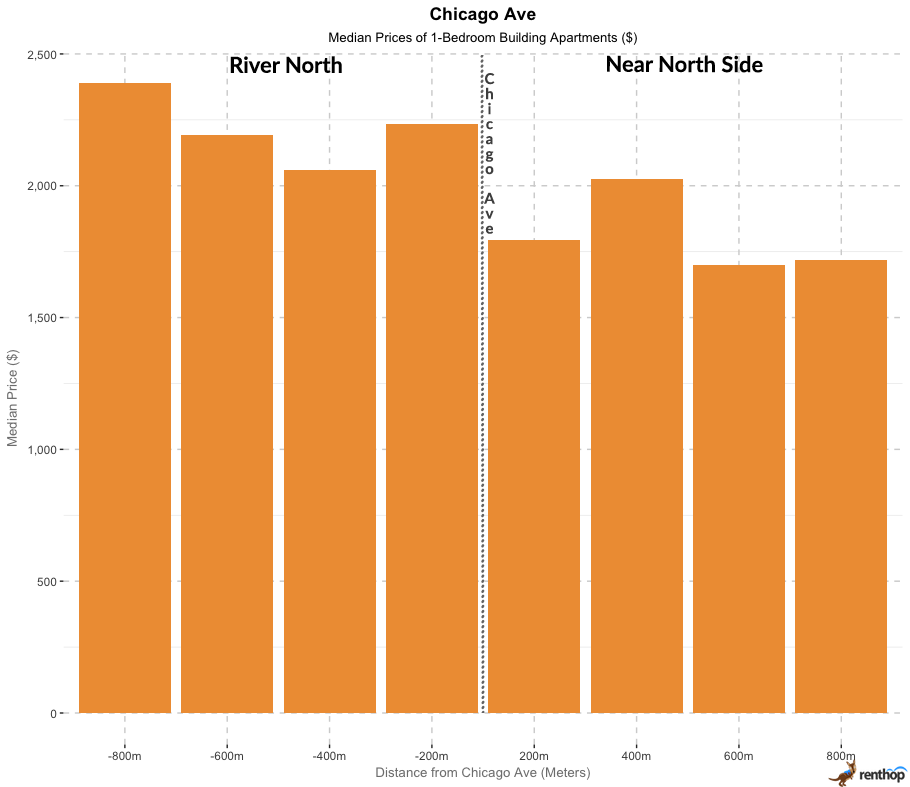
From the chart, we observe a downward trend of apartment rent prices from River North to Near North Side. A significant price drop of $440 is seen 200 m north of Chicago Avenue. Renters can expect to enjoy more price savings moving further north of the avenue. At the same time, the rise of crime and violence activities in the Cabrini-Green neighborhood might also be another factor to consider about as well.
W Devon Ave
Our findings indicated that median rents decrease from south of W Devon Ave to north of the avenue, with a significant drop of $287.50 just 400 m north of W Devon Ave.
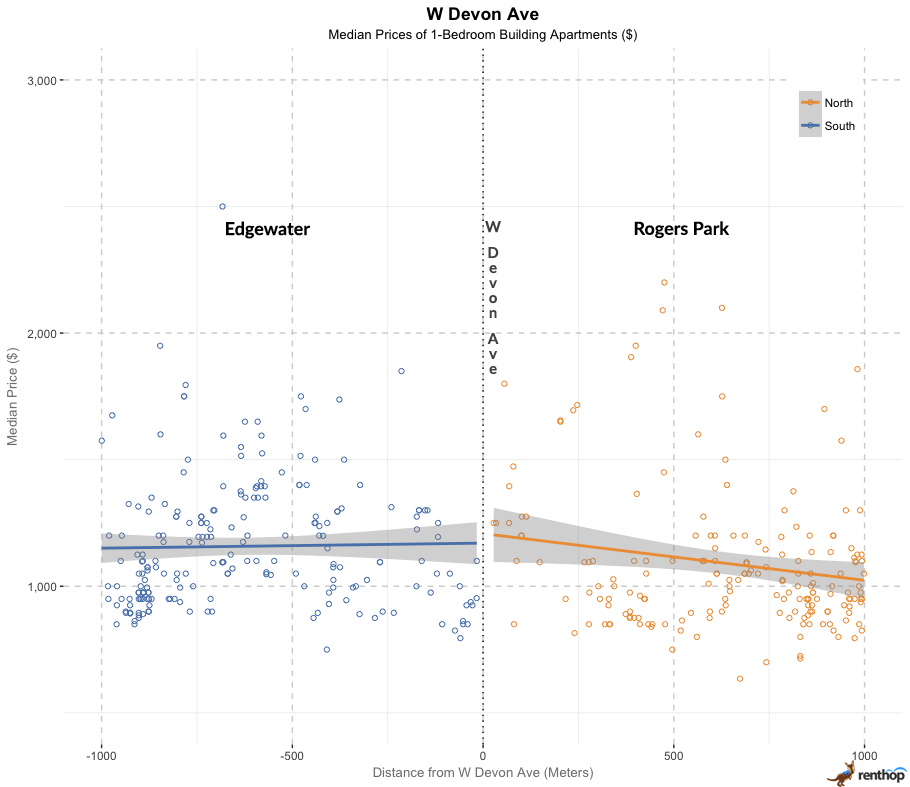
Both located on the city’s far north side, Rogers Park and Edgewater provide affordable single-family homes as compared to more expensive apartments further down in the North Side. The vicinity of Loyola University in Rogers Park and the attractive potential of these neighborhoods have drawn investors to develop the neighborhood, such as some of the recent renovation efforts in some of the buildings bought by Spirit Bascom Ventures including the 160-unit Sheridan Court at 6807 N. Sheridan Road and The Edison at 5200 N. Sheridan. But we also see a downward trend in median rents across W Devon Ave, with Edgewater generally having higher median rents than Rogers Park.
Edgewater is located further south and nearer to the city center. For young professionals and students searching for cheaper rents while still being able to commute to the city, Edgewater offers a relatively affordable option with a greater ease of convenience accessibility by the CTA Red Line as compared to Rogers Park on the far north end. Besides, sitting by the side of the lake shore, Edgewater provides a picturesque view of Lake Michigan.
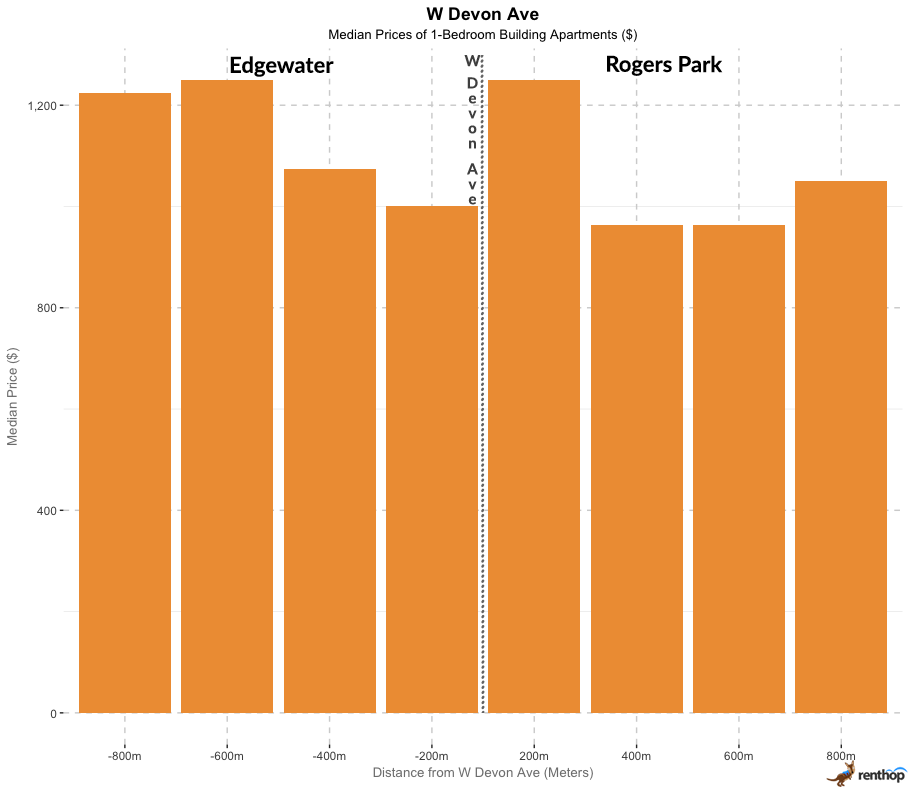
From the chart above, it is clear that there is a declining trend of 1-bedroom apartment rents apart from the anomaly of the higher rents at 200 m north of W Devon Ave. We see a price decrease of $287.50 just 400 m north of W Devon Ave. The lower number of apartment listings at 0 m to 300 m north of W Devon Ave as evident on the scatter plot could have resulted in higher rental prices in the region.
W Bryn Mawr Ave
Our findings show a general decline in rent prices from south to north of W Bryn Mawr Ave, with a $167.50 drop in median rents 200 m north of W Bryn Mawr Ave.
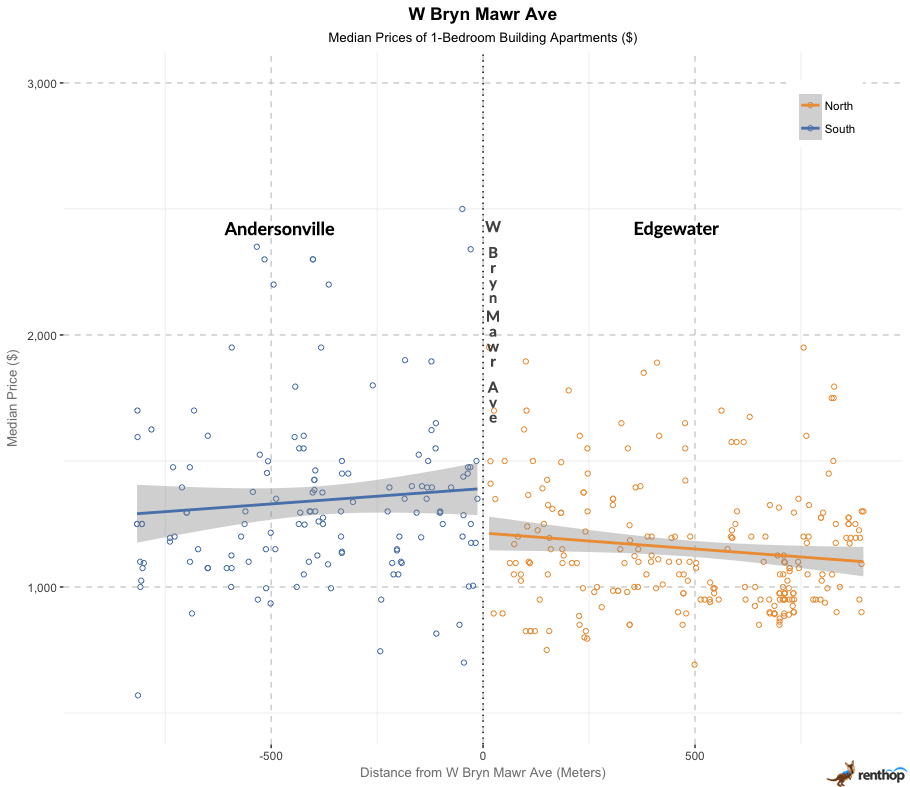
We observe that there is a sharp drop in median rents of 1-bedroom apartments across W Bryn Mawr Ave. Andersonville is a popular neighborhood tucked inside of the Edgewater neighborhood. It’s centered along Clark Street, famously known as the “restaurant strip”. On the other hand, Andersonville is a commercial historic district known to be home to independent, locally owned businesses and its lack of national chains.
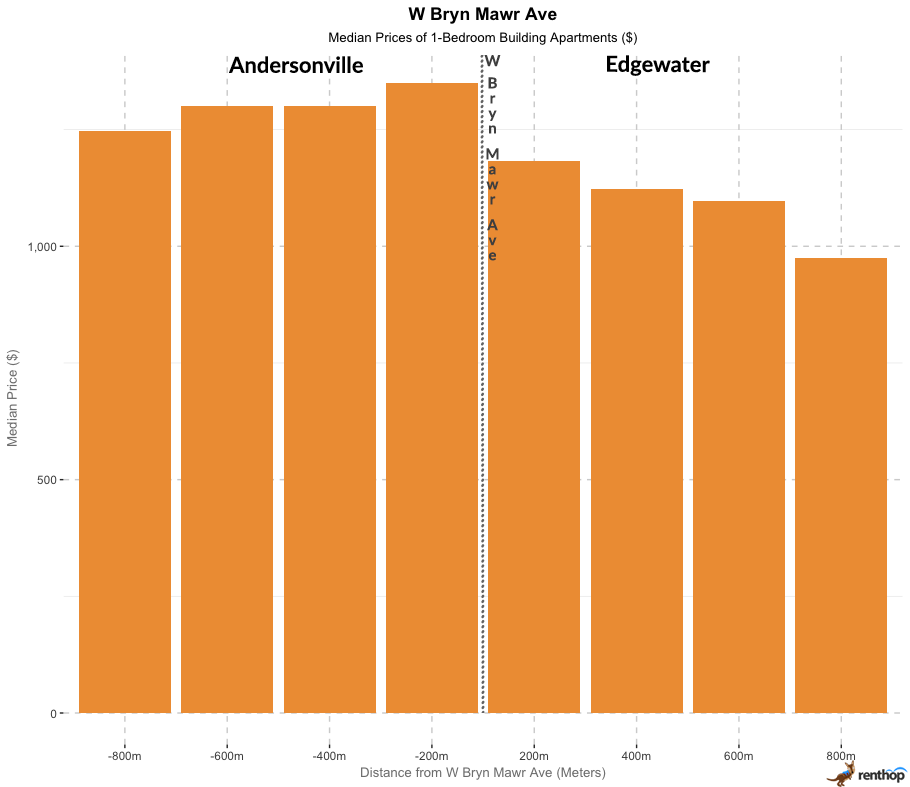
From the chart above, we see a general trend of declining rent prices from south to north of W Bryn Mawr Ave, with a prominent drop in median rents by about $167.50 at 200 m north of W Bryn Mawr Ave.
W Diversey Pkwy
Our findings revealed a price drop of $130 just 200 m north of W Diversey Pkwy.
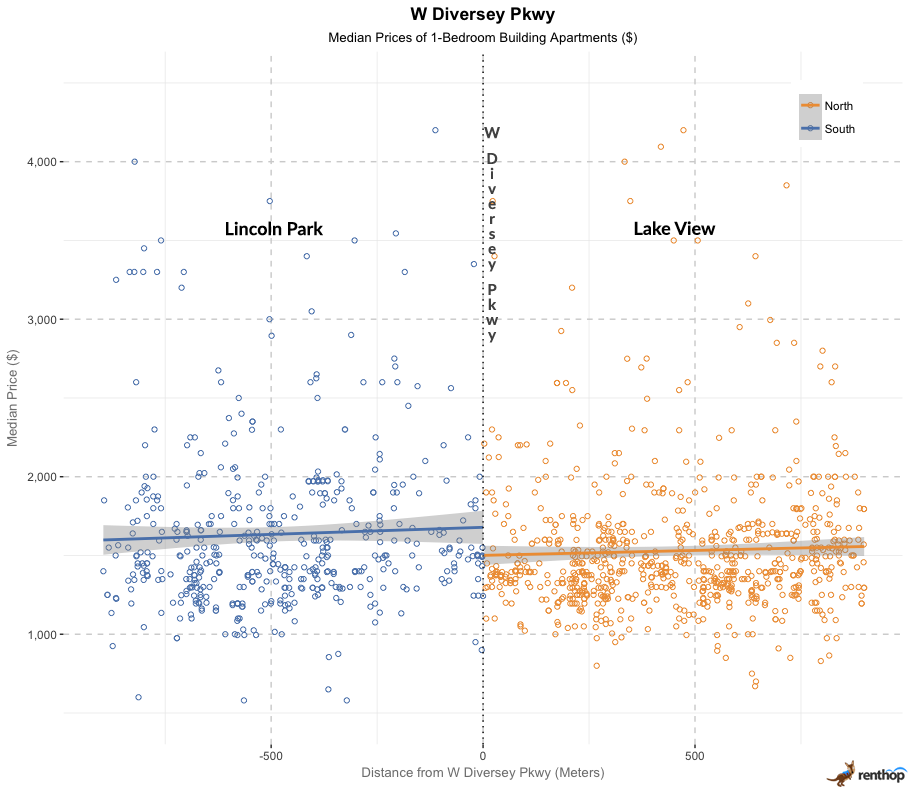
Here, we learn that rent prices north of W Diversey Pkwy is generally lower than the south. Both Lake View and Lincoln Park are fairly accessible by CTA’s ‘L’ line public transit, and they’re close to downtown Chicago. It’s no secret that Lake View is a vibrant, youthful and urban neighborhood with many attractions and amenities including restaurants, bars and the Wrigley Field which is famous for hosting the Cubs games. While the CTA Red, Brown and Purple lines serve Lake View, the neighborhood doesn’t offer convenient access to Chicago’s expressway grid, with lengthier commute times to downtown Chicago.
On the other hand, Lincoln Park might pose as a more accessible option to the city center. It’s known to be a rich neighborhood lined with picturesque streets. Not only that, with CTA brown, red and purple lines serving the neighborhood, residents in this area can expect easier access and shorter commute times to anywhere in the city. Another factor could be that the DePaul University is located within Lincoln Park, which may have commanded higher rental prices in the neighborhood, which might further explain the drift in prices across the parkway.
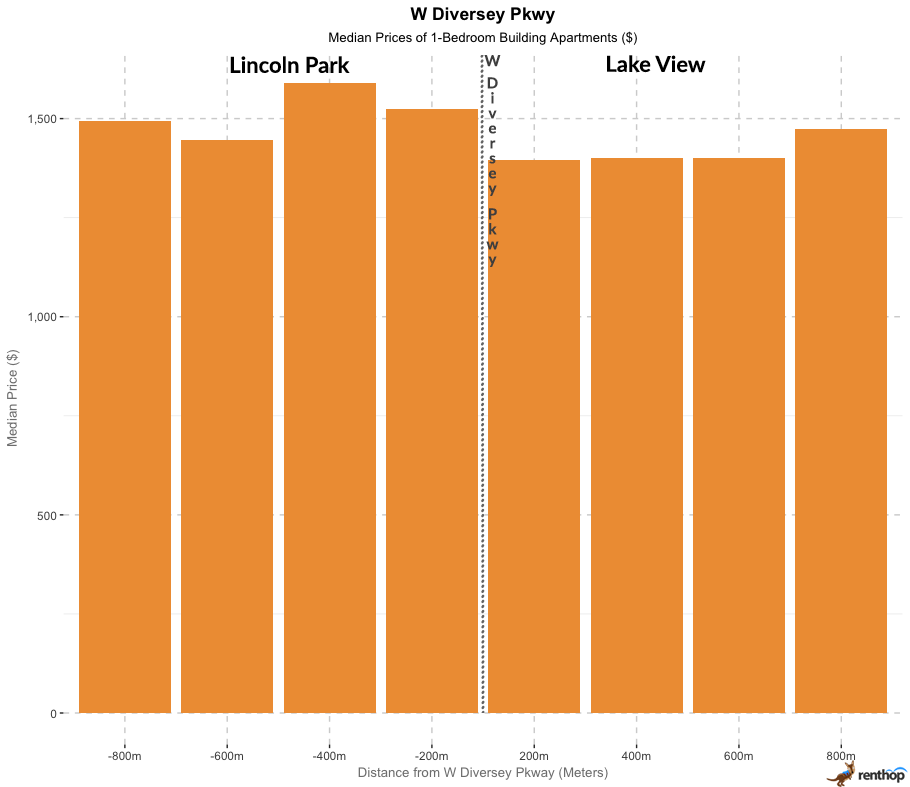
Across W Diversey Pkwy, we found that median rents drop by $130 per month at 200 m north of the parkway before remaining relatively stable from 200 m to 600 m.
W Fullerton Ave
We observed a price drop of $157.50 per month at 200 m south of W Fullerton Ave.
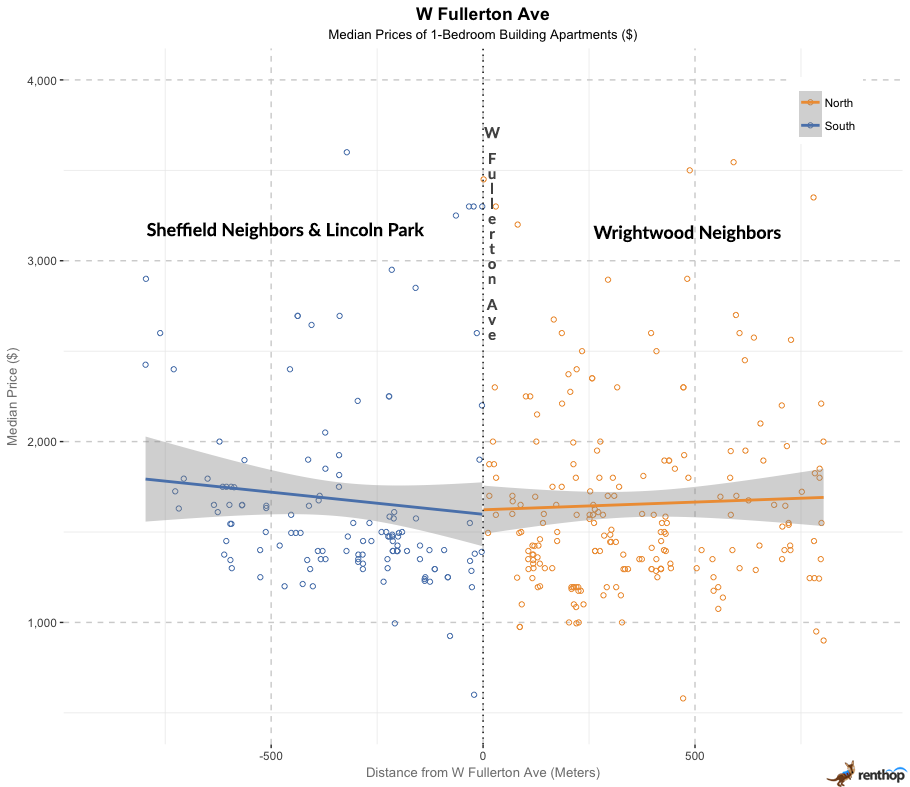
We see that the rent prices fall towards W Fullerton Ave before picking up again north of the avenue.
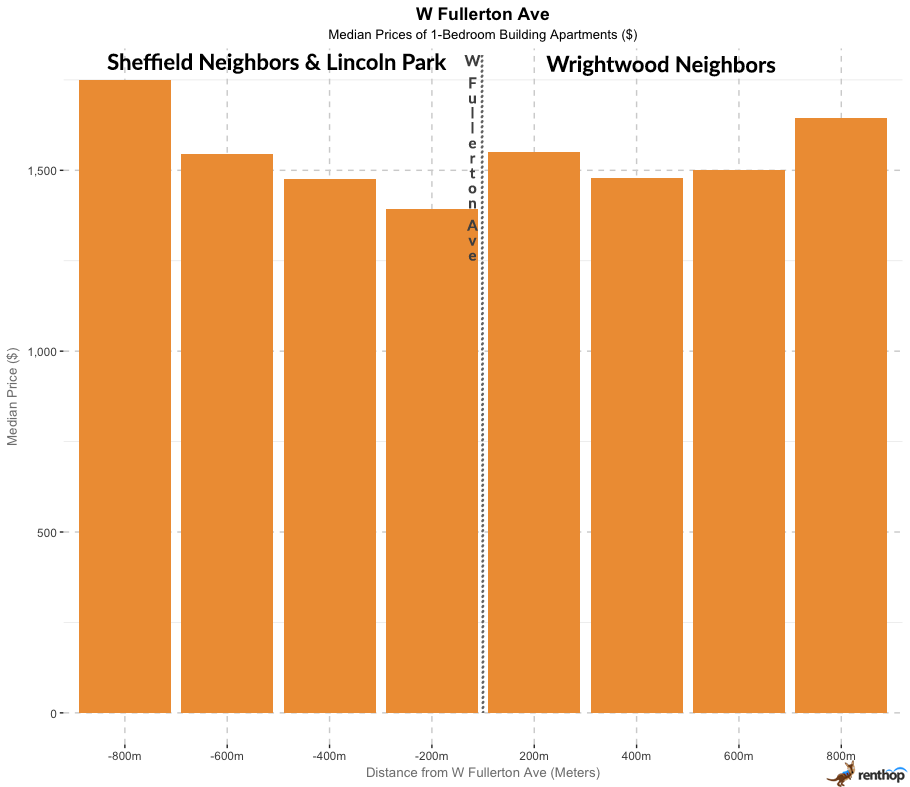
The trend of rent prices decreasing towards W Fullerton Ave is also apparent from the chart above. We observe a drop in median rents 200 m south of the avenue, by about $157.50. It is highly likely that the price drop is influenced by the vicinity of DePaul University in the Lincoln Park neighborhood. Apartments in the same space as the university would experience a higher level of noise and street activity. Another reason might be the fact that the apartments surrounding the university being more affordable for university students who are looking for off-campus housing while being near their school.
What does this mean for renters?
From the data, we see that median rents decrease as the distance from the city center rises. Our analysis has also revealed that by renting apartments 200 m north of Chicago Ave in Near North Side, renters can save a significant amount of about $440 per month. In neighborhoods further away from the city center, such as Lincoln Park and Lake View, renters can also save about $130 per month by moving 200 m north of W Diversey Pkwy in Lake View. While apartments further away from the city center exhibit a trend of lower median rents, the accessibility to Chicago’s train system is also another factor to consider as it may come as a tradeoff to some renters. With just the CTA Red and Purple Lines serving neighborhoods such as Rogers Park and Edgewater, renters should anticipate the possibility of having alternative means of transportation should they choose to live in neighborhoods further away from the city center. On the other hand, renters should also take into account the safety level of their neighborhoods and carry out research on neighborhood crime and safety.
Methodology
The data used in this analysis is derived from RentHop’s listings from January 2016 to March 2018. Listings with the same address are de-duplicated into a single point as they suggest apartments are in the same building. *Note: As data points are sparse in some regions of the plots, the median prices are aggregated by 200 m intervals to provide a better picture of the pricing trends.




